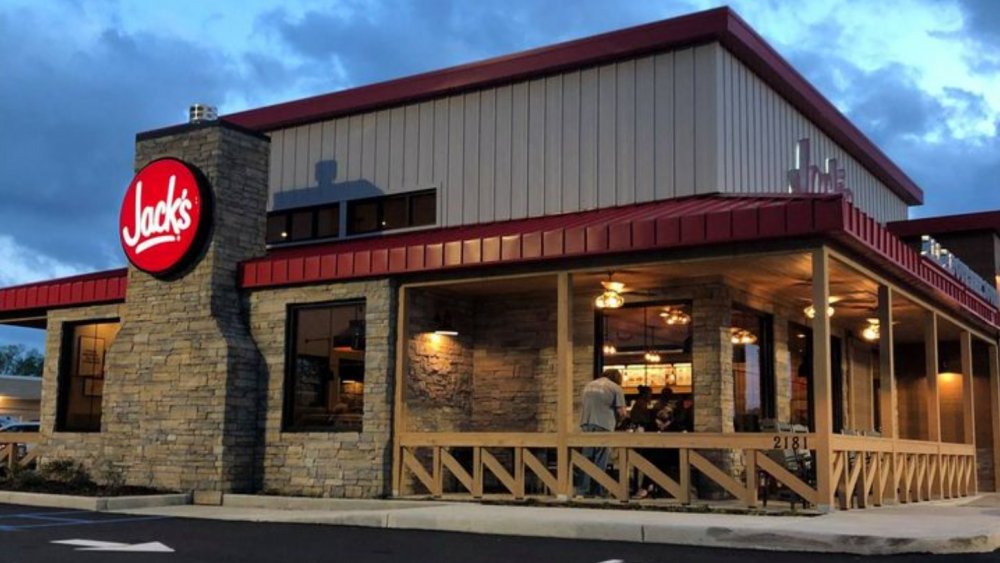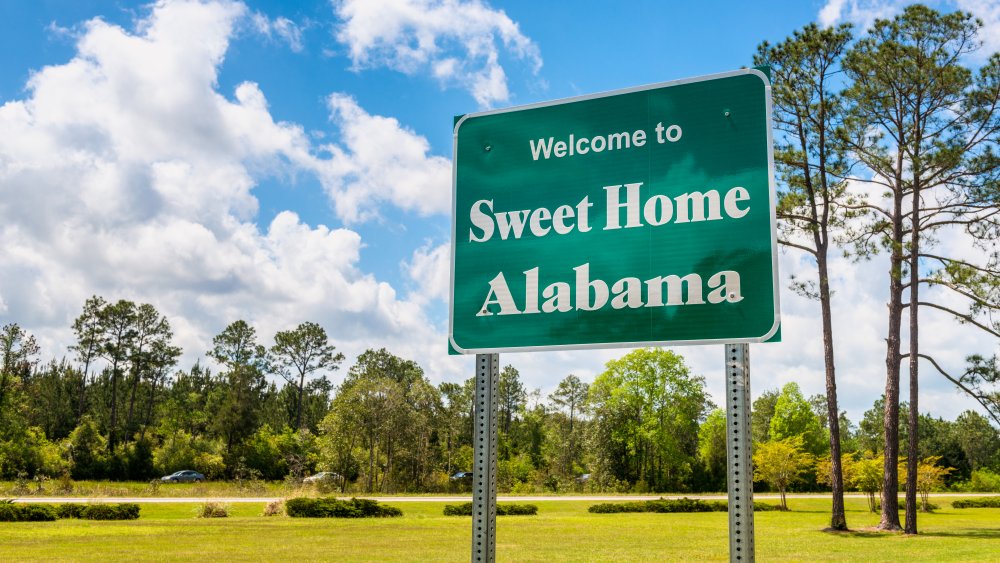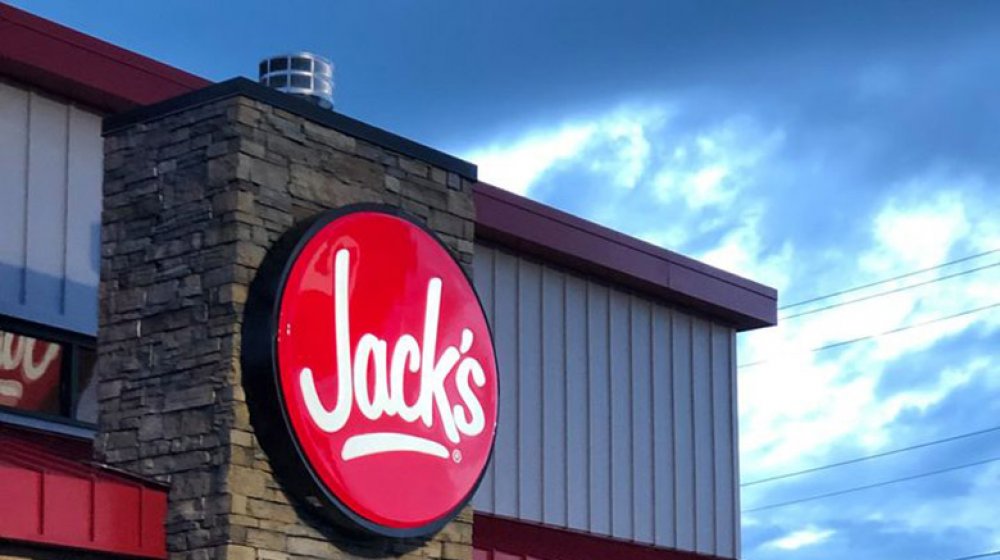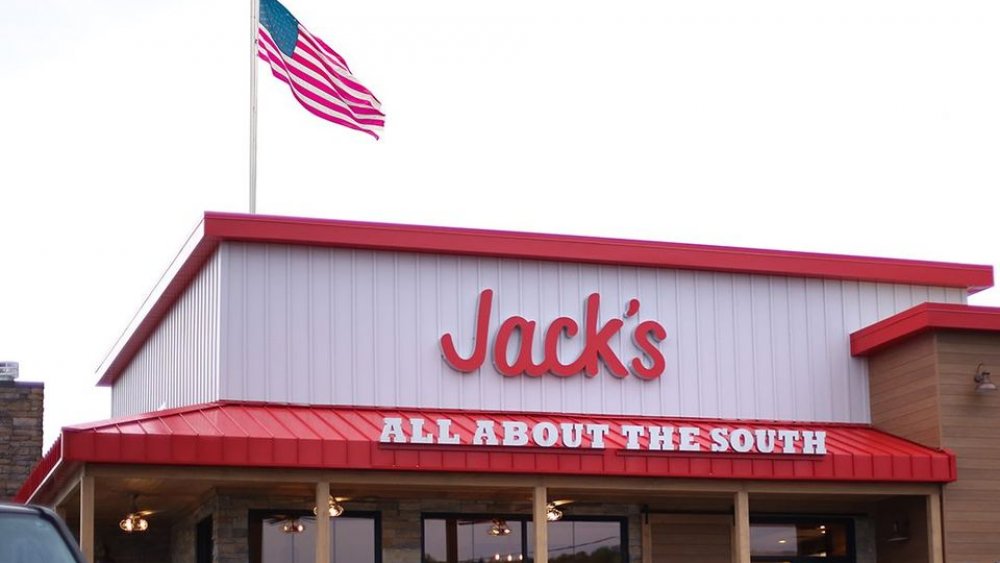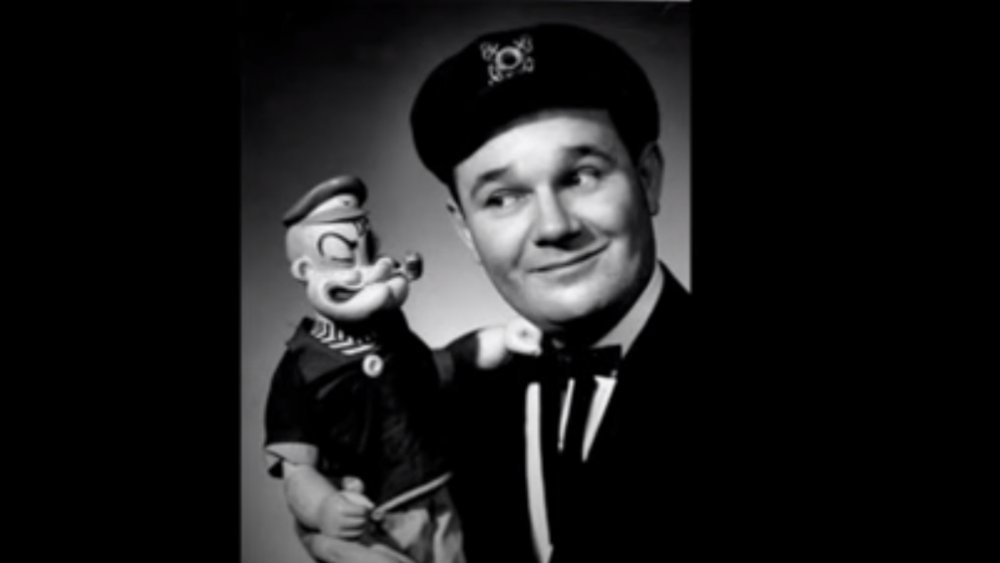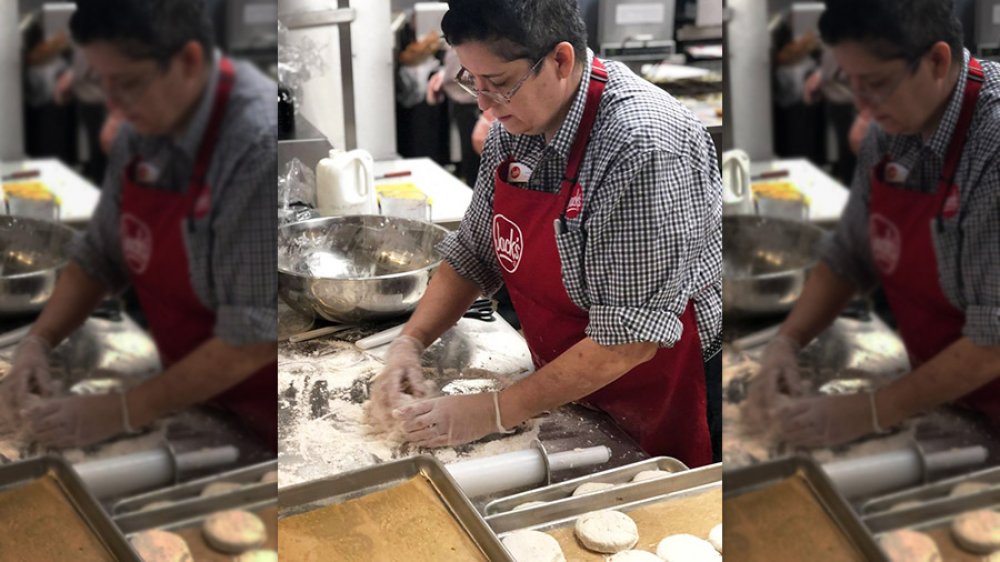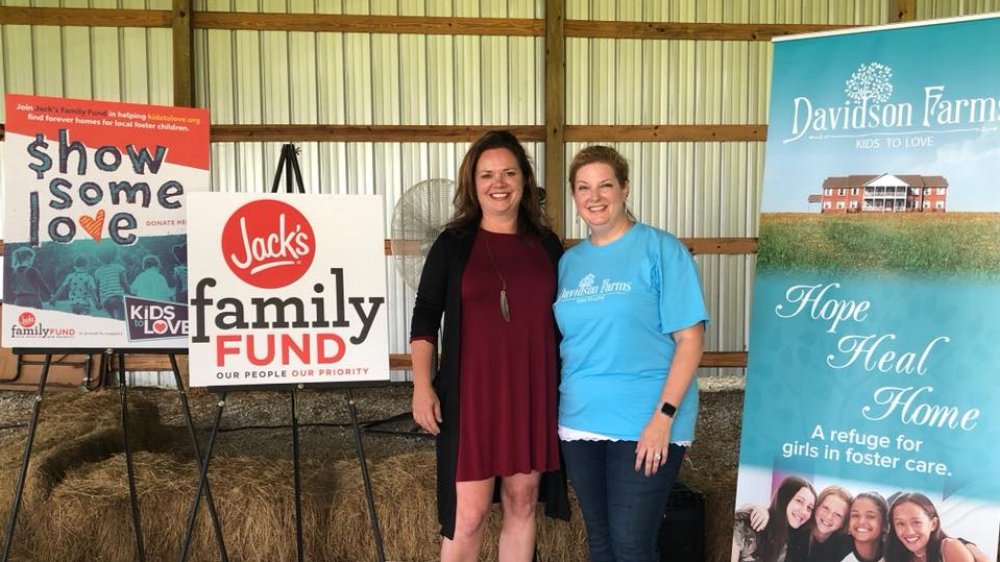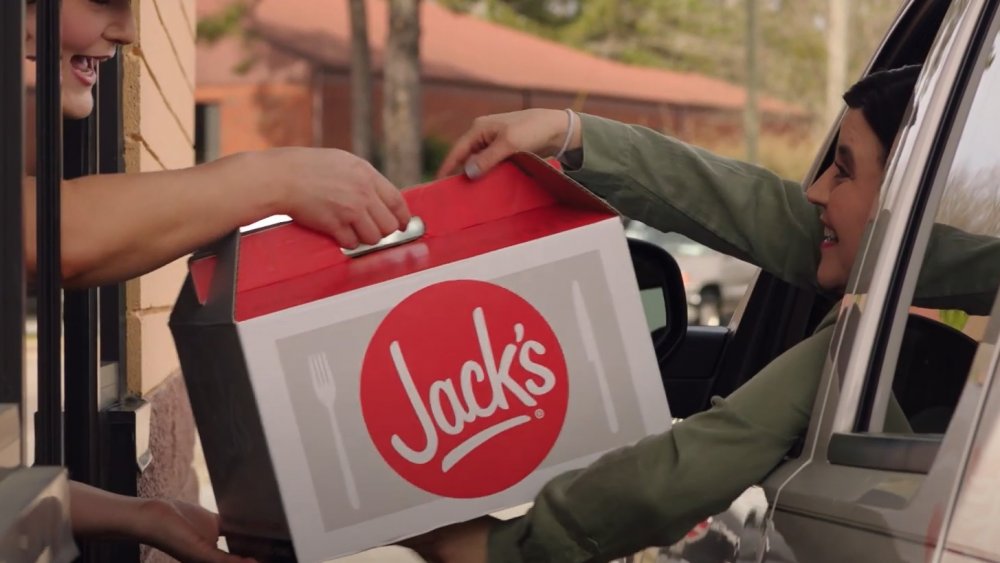The Untold Truth Of Jack's
Jack's or Jack's Family Restaurants (not to be confused with Jack in the Box) was among the early fast food pioneers to emerge in the United States, even before Wendy's, Taco Bell, or Subway. The chain was born just when McDonald's was becoming popular in California and KFC was coming up in Kentucky. While McDonald's and KFC have fiercely expanded to over 100 countries, Jack's hasn't stepped outside of the United States. Even within the country, it hasn't marked its presence in any of the states to the north of Tennessee or the west of Mississippi.
Compared to other fast food giants, the 60-year-old chain has maintained a low profile. Comfortable with its popularity in a small section of the country, it has been quietly working hard to better its biscuits. The chain's history is so intertwined with the culture of the South, that even today, it strives to maintain this bond to its roots by adopting a décor and menu that's "All about the South." The chain's story is a story of the American fast food industry itself and it begins at a time when one could buy a hamburger at 15 cents and a Coca-Cola for 10 cents.
Here are some little-known facts about the fast food chain that believes in growing where it was sown.
Jack's was the first fast food joint in Alabama
During the economic expansion post-World War 2, two brothers named Richard and Maurice McDonald started a drive-up restaurant in California that became popular in the rest of the country by the late 1950s. The McDonald's hamburger chain inspired a gentleman in a small town in Alabama to start something similar. Restaurateur Jack Caddell started Jack's Hamburgers in his hometown of Homewood, a suburb of Birmingham, Alabama. At his fast food stand, he sold hamburgers, French fries, milkshakes, and fish-on-a-bun. Much like McDonald's.
Caddell had been in the restaurant business for a while. He had owned a barbecue restaurant and another popular hangout called Pig Trail Inn in Homewood, before he launched what would be the very first fast food chain in Alabama (via Encyclopedia of Alabama). In fact, Caddell was not far behind in the race. Though the first fast food chain in the States is largely credited to White Castle, which opened in Kansas in 1921, the concept of a quick-service restaurant industry really started picking up in the United States only in the '50s and '60s, with the emergence of highways (via Smithsonian Magazine).
You can still get a hamburger in Jack's very first location in Homewood, where it all began.
Jack's used to be a walk-up hamburger joint
The first Jack's in Homewood was nothing like the elaborate dine-in that is it today. Shades Valley Sun, in a report published in 1960 — the year of the chain's launch — stated that the walk-up stand was an all-metal construction 21-by-32 feet, and had high-tech equipment of that time to ensure quick service. They had shake machines that could make 36 shakes in three minutes, automatic coffee machines that made 500 cups of coffee an hour, and heated tables with sliding racks that could make fries at an accelerated rate. These appliances were novel in the early 1960s.
Back then Jack's was called Jack's hamburgers, and its stands had yellow and orange stripes on their walls. In the late '60s, the chain underwent a makeover. The walk-up stands were converted into dine-in facilities, and the logo which until then had the words "Jack's" and "Hamburgers" in two separate rectangles, now featured a red circle with the name "Jack's" written in white — similar to how it is today (via Encyclopedia of Alabama).
In 2018, the brand worked with a San Francisco-based brand strategy and retail design firm Tesser to develop a new store design that featured a "wrapped" porch" with seating and on the inside, round dining tables, and an old-fashioned ice cream counter to boot, Mountain Eagle reports. More emphasis was also placed on spotlighting Jack's biscuits. Since 2018, several of its restaurants were remodeled to reflect this new design.
Jack's presence is only in the South
Though Jack's expanded in number at a stunningly fast rate, geographically it has been hesitant to go beyond the comfort of the South. After establishing its first walk-up stand in Homewood, Alabama, the chain was unstoppable as it expanded to other areas within the surrounding Birmingham area such as Bessemer and Alabaster, and across the state to Huntsville and Montgomery. Jack's would expand beyond Alabama — but in a measured way — and entered neighboring states Mississippi and South Carolina. But before the chain completed 10 years, it was 57 locations strong! In fact, Jack's saw such success in the 1960s that it delayed the mighty McDonald's from conquering the Birmingham market.
Cut to 2020, and there are close to 200 Jack's restaurants and they are all crowded within Alabama, Georgia, Tennessee, and Mississippi.
The chain is comfortable being a home bird that doesn't migrate beyond a small radius. If you look back into the history of its growth, as Benny LaRussa, a former owner of the chain, said, the brand "has prospered by focusing on customer service and locating largely in small, under-served towns across rural Alabama, home to 100 of its restaurants." They continue to be in demand in their target states. "We want to be a great regional player in the Southeast where really our brand resonates with our guests and sort of the Southern lifestyle," Todd Bartness, Jack's CEO, told Birmingham Business Journal in 2018.
Jack's has sponsored several children's shows
The official launch of the first Jack's location was specially catered to the kids. The event was held the day after Thanksgiving in 1960, and the holiday vibe was already in the air. So Jack's brought Santa Claus as a special guest on the occasion, as reported in the book Christmas in Birmingham by author and historian Tim Hollis. Accompanying Santa was "Cousin Cliff" — a popular children's show host in the '50s and '60s in Alabama. He had a huge fan base among kids and their parents, as he did five shows a week with each show featuring 20 to 30 children. If you are a baby boomer, there is a good chance you might have heard of Cliff's two popular shows: The Cousin Cliff Clubhouse and The Popeye Show.
According to Hollis, part of the strategy Caddell used to build Jack's into a million-dollar venture within a short period of time was by directing the bulk of his advertising toward the children's market. Caddell had a strategy to promote his business: keep five cents of every dollar you make for advertising. This way, he could sponsor several children's show hosts at the time. Some examples besides Cousin Cliff are Benny Carle – the first kid's show host in Birmingham, Bozo the Clown, the Romper Room ladies, and Sergeant Jack (the Jack in his name comes from the restaurant's name).
Jack's was once owned by a Canadian company
Isn't it interesting that Jack's, which never expanded north beyond the borders of Tennessee, was at one point owned by a Canadian company? In 2015, Toronto-based Onex Corporation bought the company, with its 169 stores then, for $234 million, and sold it after four years in 2019 for $835 million. Lucky Onex, it almost tripled its investment.
Before Onex came into the picture, the company was tossed from one hand to another like a hot burger. Founder Jack Cadell sold his less than 10-year-old company to Florida Capital in 1969. Under their watch, the company saw rapid growth until they faced a big challenge in the 1980s. There was a lot of competition from other fast food chains that had mushroomed left, right, and center. Jack's found it hard to keep up, and had to shut many of its stores.
But thanks to the brilliant business acumen of a certain wholesale grocery supplier and Jack's franchise owner Benny LaRussa, the company bounced back in the late '80s and '90s. LaRussa had started off with owning one franchise of Jack's in the '60s to 13 by 1970 to 33 by 1988! He bought the sole franchise rights from Florida Capital and nursed the company back to its glory of the 1970s (via Encyclopedia of Alabama).
Jack's biscuits are made in-house each morning
Biscuits, as you know, are a quintessential Southern breakfast food. Jack's embraces this fact almost too well in its restaurants that go by the tagline: "All about the South." The fast food chain offers a variety of biscuits on its menu: the chicken biscuit, bacon biscuit, and sausage biscuit. Then there is the whole treasure chest of secret menu items that include smoked sausage, egg and cheese biscuit; steak, egg and cheese biscuit; and ham, egg, and cheese biscuit. If you are lucky, they might have bologna biscuits, which are usually only available for a limited time.
In most Jack's restaurants, you can see the biscuits being made right then and there. Jake Taylor, VP of marketing with Jack's, said "You won't find any pre-made biscuits out of a frozen cardboard box in our kitchens." They are all scratch-made using flour, buttermilk, and butter. Taylor said that it is the biscuit maker who arrives first at the restaurant each day — at about 4 a.m. before the drive-through opens for business (via PR Newswire). The company sells 96,000 biscuits each day — that's 3,360,000 every year, according to their website.
If you are a biscuit maker at Jack's, you get to participate in the annual biscuit bake-off. The event has participants from across Jack's stores competing for the title of "Best Biscuit Maker" and a cash award of $1,000.
Jack's has its own non-profit foundation
Most fast food chains have their own non-profit organizations through which they contribute to society. For example, McDonald's has the Ronald McDonald House which aims at helping sick or injured children; and Burger King has The Have It Your Way Foundation which focuses on raising funds to send children to college (via KCET). Following the trend, Jack's started its own non-profit organization in 2018. Called Jack's Family Fund, the organization provides financial help to its employees and the communities that it has a presence in, in times of need.
The starter funds for the organization came from Jack's employees themselves. In 2018, one of its employees even did a 225-mile charity bike ride from the Alabama Mississippi State line to the Alabama Georgia State line to raise $25,000 for Jack's Family Fund. The organization's first fundraiser was organized in partnership with Kids to Love, a non-profit which provides homes to foster children. All the funds that were accepted from guests at the restaurants went towards the benefit of Kids to Love non-profit.
Jack's Family Fund, according to their website, is helping organizations such as United Way's Meals on Wheels, United Way of Central Alabama, Second Harvest Food Bank of Middle Tennessee, Food Bank of East Alabama, among others.
Jack's original 15-cent jingle is now a song
If you were born in Alabama, specifically in the Birmingham area, in the '60s and '70s, there is no way you haven't heard their widely popular "15-Cent Jingle." It goes like "You'll go back, back, back to Jack, Jack, Jack's for more, more, more," and was used in the chain's promotional campaigns for many years. When the chain turned 50 in 2010, the jingle was revived into a three-minute song at the same studio — Boutwell Studios in Homewood, Alabama — where the original jingle was taped (via AL.com).
The original was written by Henry Kimbrell, a popular jazz pianist from Birmingham, AL. It was used to promote the chain's 15-cent hamburgers during children's television shows. For the revived version, it was Kimbrell's sons — guitarist Mark Kimbrell and drummer Matt Kimbrell — who played the music. Besides the guitar and trumpet that's in the original, the new version also includes a banjo and fiddle. The intention, however, was never to broadcast. All that hard work? Turns out, it was played at an employee celebration event on the occasion of its golden jubilee celebrations. Modern versions of the jingle in the styles of rock, pop, country, and R&B have been used in the brand's commercials.
Jack's has had a few mascots over the years
Back in the 1970s, Jack's had Quacker Jack as its mascot (via Birmingham Rewound). No, not the villainous Disney character from Darkwing Duck, this one was a rather cuddly-looking bird. Jack's mascot appeared around the time Kellogg's Smacks got its popular mascot Dig 'Em and Nesquik got its bunny mascot named Quicky (via Insider). In the '80s, kids who ate at Jack's got a Quacker Jack Surprise Pack that included small toy animals (the toys were later recalled for the reason that they might pose a choking danger for kids under three years).
Quaker Jack wasn't as lucky as Dig 'Em and Quicky, and though it isn't certain what happened to it, we know that Jack's had moved on from the modest duck to a feisty little rooster Jumping Jack. There are a ton of Jack's yesteryear (when Jack's used to offer a steak finger basket for just $1.99) promotional ads on YouTube, featuring the rooster along with the animated avatars of two popular Alabama-based radio show hosts Rick Burgess and Bill "Bubba" Bussey of The Rick and Bubba Show fame.
Jack's began serving breakfast 19 years after its launch
In the late 1970s, breakfast was becoming a popular option in the quick-service restaurant industry. McDonald's kickstarted the trend by offering a breakfast menu in 1976. Burger King followed suit in 1978, and Jack's in 1979. The popularity of the fast food breakfast has only grown with time. According to Fox Business, between 2015 to 2019, the breakfast sector of fast food has grown at 7.7 percent with an overall spending bump of 31 percent.
Jack's introduced breakfast as an option across its chains 19 years after its launch. But once it did take flight, it stayed on (unlike Wendy's which failed repeatedly in its attempt to launch a breakfast menu). The restaurant offers everything from an array of biscuits to a breakfast wrap and more standard fare such as pancakes, hashbrowns, and a Big Breakfast Sandwich. While they serve their classic chicken biscuits and butter biscuits all day, other breakfast options are available only until 11 a.m.
